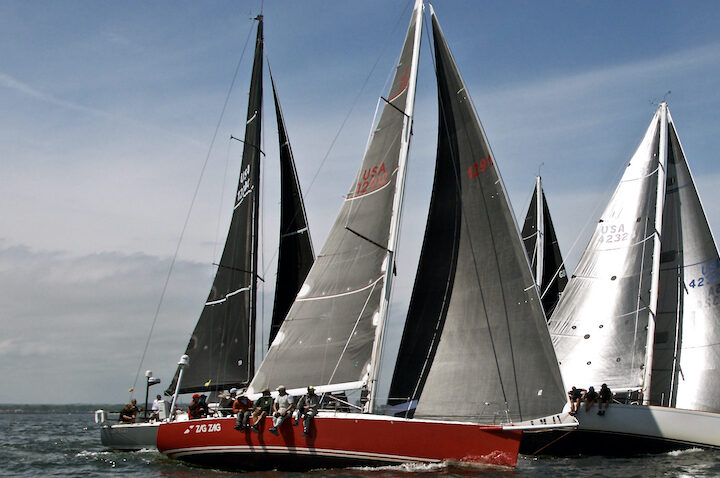Code Zeros, initially exploiting a rule loophole, have transformed into a distinct class of sails, revolutionizing the world of boat racing. This category encompasses a wide array of shapes and sizes, each holding the key to unlocking a range of performance benefits. Let’s explore the world of Code Zeros, examine how tweaking their dimensions can impact your sail’s performance, heel, and rating, and discover how to get the most out of your sail.
Introducing the Code Zero – Unveiling an Ingenious Loophole
The inception of the modern Code Zero sail can be traced back to the 1997/1998 Whitbread Race, where it graced the sails of Paul Cayard’s EF Language. His team stumbled upon an innovative approach – crafting a sail that mimicked the appearance and performance of a jib/genoa while still satisfying the measurement criteria of a spinnaker. This was achieved by designing a sail with a wider midgirth, meeting the minimum requirements for a spinnaker. Their ingenious idea pioneered a new era in sail design, exploiting a previously uncharted loophole.
Understanding Mid Girth Measurements – A Quick Insight into Sail Terminology
Before we delve deeper, let’s clarify the concept of mid girth percentages. Mid girth is the measurement from the midpoint of the leech to the midpoint of the luff. This measurement is then divided by the foot length to determine the mid girth percentage. For instance, a sail with a 7.5-meter mid girth and a 10-meter foot would have a 75% mid girth.
The Impact of Mid Girth on Sail Performance – Why Size Matters
The mid girth percentage has a profound effect on a sail’s performance. Smaller mid girth values result in flatter sails that can point higher into the wind. The reduced material on the back of the sail minimizes drag, preventing heeling and maintaining speed, especially when sailing close to the wind. In contrast, larger mid girth values produce deeper sails, better suited for broader sailing angles.
A common misconception is that a deeper Code Zero performs better in light air. However, these sails are inherently deeper than upwind headsails, and their power is generated through sheer size, often ranging from 2 to 2.5 times that of a typical headsail. Hence, the depth primarily dictates the sail’s optimal sailing angles.

Choosing the Right Mid Girth for Your Sail – Navigating the Rating Rules
The choice of mid girth for your sail depends significantly on the specific rating rule governing your sailing competition. Various rules impose different penalties for Code Zeros based on their mid girth percentages.
For example, under (most) PHRF rules, there is no penalty for mid girth values above 75%. However, mid girth percentages between 65% and 75% are penalized equally. This encourages sails that hover just above the 75% mid girth or rest squarely at 65%. ORR and IRC also treat mid girth percentages above 75% as spinnakers without additional penalties, but take a more nuanced approach for values below 75%, resulting in a wider range of possibilities. ORC, on the other hand, considers sails with mid girth percentages under 85% and rates them accordingly, with a slightly different treatment for those below 75%. With these variations in mind, choosing the ideal mid girth can be a complex decision.
Sail Purpose and Design – Tailoring the Code Zero to Your Needs
The most pivotal factor in determining the design and mid girth of your Code Zero sail is its intended use and how it complements your sailing strategy. In essence, the closer your sail needs to point to the wind, the smaller the midgirth and overall size of the sail.
For upwind-style Code Zeros, which are designed to point high into the wind, a smaller mid girth is preferred. These sails are typically trimmed inboard on a jib or genoa track, emphasizing a flatter profile. The performance boost often outweighs any rating penalties associated with smaller mid girth percentages. These sails are commonly found with mid girths in the low to mid 60’s, however they can go even lower if the rating and performance dictate it.
However, when the Code Zero is destined for downwind work or complements other sails designed for reaching, rating rules are less likely to take a penalty for mid girth values under 75%. In such cases, sails can be deeper to accommodate the added area.

Dealing with Flapping – The Dilemma of the Code Zero
One common issue that sailors encounter when using Code Zeros is their propensity to flap at the leech. This flapping is a result of the added sail area required to conform to the mid girth rule. Surprisingly, removing this excess area would result in a faster sail. Eliminating the flapping can be achieved by either accepting a rating penalty and reducing mid girth or increasing the sail’s depth, particularly at the leech. However, increasing depth often leads to more drag, heel, and reduced speed. Thus, sailors are left with a choice between eliminating flapping or maintaining optimal performance.
Unlocking the Loophole: Code Zero Mid Girth Explained
In the intricate world of Code Zero sails, selecting the right mid girth is an art that depends on the unique dynamics of your sailboat, your racing rules, and your sailing goals. Whether you’re aiming to add upwind or reaching performance, understanding the nuances of mid girth percentages will empower you to make the most informed decisions for your sail and dictate how best to use them.


